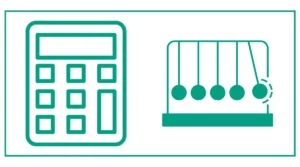Mechanical Advantage Calculator
You can calculate the mechanical advantage of the lever, pulley, screw, wedge, ramp, wheel, and axis system by using this MA calculator.
Enter the effort arm and load arm for the lever to find the mechanical advantage.
Input the number of pulleys for the pulley system.
Enter the wedge length and thickness for the wedge system.
Input the ram length and height for the ramp system.
For the wheel and axis system, input the wheel and axel radius.
In case you don’t know, the ratio of the force that a machine produces to the force that is put on it is known as mechanical advantage. This is used to measure how well a machine works.
MA = FB/F
MA = the mechanical advantage
FB = force of the object
FA = Effort to overcome the force of the object

You might want to figure out the resultant force and gravitational energy.
What is Mechanical Advantage?
Mechanical advantage (MA) is a measure of how much a machine or tool amplifies the force applied to it. In simple terms, it’s the ratio of the output force to the input force. When a machine has a mechanical advantage greater than 1, it multiplies the input force, making it easier to perform tasks that would otherwise require more effort.
The formula for mechanical advantage is:
MA = Output Force / Input Force
or
MA = Distance of Effort / Distance of Load
Types of Simple Machines and Their Mechanical Advantage
Our mechanical advantage calculator covers six fundamental simple machines. Let’s explore each one and how to calculate its mechanical advantage.
1. Lever
A lever is a simple machine consisting of a rigid bar that rotates around a fixed point called the fulcrum. There are three classes of levers, each with its own mechanical advantage calculation.
Calculating Mechanical Advantage of a Lever
For all lever types, the mechanical advantage is calculated using the following formula:
MA = Effort Arm / Load Arm
Where:
- Effort Arm is the distance from the fulcrum to the point where the effort is applied
- Load Arm is the distance from the fulcrum to the load
To use the lever section of our mechanical advantage calculator:
- Enter the length of the effort arm in meters
- Enter the length of the load arm in meters
- The calculator will automatically compute the mechanical advantage
Example: If a lever has an effort arm of 2 meters and a load arm of 0.5 meters, the mechanical advantage would be:
MA = 2 / 0.5 = 4
This means the lever multiplies the input force by a factor of 4.
2. Pulley
A pulley is a wheel with a grooved rim around which a cord passes. It’s used to change the direction of an applied force and can provide a mechanical advantage when multiple pulleys are used in a system.
Calculating Mechanical Advantage of a Pulley System
The mechanical advantage of a pulley system is determined by the number of supporting pulleys:
MA = 2 * Number of Supporting Pulleys
To use the pulley section of our calculator:
- Enter the number of supporting pulleys
- The calculator will display the mechanical advantage
Example: In a pulley system with 3 supporting pulleys, the mechanical advantage would be:
MA = 2 * 3 = 6
This system would reduce the effort required to lift a load by a factor of 6.
3. Screw
A screw is an inclined plane wrapped around a cylinder. It converts rotational motion into linear motion and can provide a significant mechanical advantage.
Calculating Mechanical Advantage of a Screw
The mechanical advantage of a screw is calculated using the following formula:
MA = (π * Diameter) / Lead
Where:
- Diameter is the outer diameter of the screw
- Lead is the distance the screw advances in one complete rotation
To use the screw section of our calculator:
- Enter the diameter of the screw in millimeters
- Enter the lead of the screw in millimeters
- The calculator will compute the mechanical advantage
Example: For a screw with a diameter of 10 mm and a lead of 2 mm, the mechanical advantage would be:
MA = (π * 10) / 2 ≈ 15.71
This screw would multiply the input force by approximately 15.71 times.
4. Wedge
A wedge is a triangular-shaped tool used to separate objects or lift loads. It’s essentially a portable inclined plane.
Calculating Mechanical Advantage of a Wedge
The mechanical advantage of a wedge is calculated using the ratio of its length to its width:
MA = Length / Width
To use the wedge section of our calculator:
- Enter the length of the wedge in centimeters
- Enter the width (thickness) of the wedge in centimeters
- The calculator will determine the mechanical advantage
Example: If a wedge has a length of 20 cm and a width of 4 cm, its mechanical advantage would be:
MA = 20 / 4 = 5
This wedge would multiply the input force by a factor of 5.
5. Ramp (Inclined Plane)
A ramp, or inclined plane, is a flat supporting surface tilted at an angle to the horizontal plane. It’s used to raise or lower objects with less effort than lifting them vertically.
Calculating Mechanical Advantage of a Ramp
The mechanical advantage of a ramp is calculated using the ratio of its length to its height:
MA = Length / Height
To use the ramp section of our calculator:
- Enter the length of the ramp in meters
- Enter the height of the ramp in meters
- The calculator will compute the mechanical advantage
Example: For a ramp that is 6 meters long and rises to a height of 1.5 meters, the mechanical advantage would be:
MA = 6 / 1.5 = 4
This ramp would reduce the effort required to lift a load by a factor of 4.
6. Wheel and Axle
The wheel and axle is a simple machine consisting of a wheel attached to a smaller axle. It’s used in many applications, from doorknobs to car steering wheels.
Calculating Mechanical Advantage of a Wheel and Axle
The mechanical advantage of a wheel and axle is calculated using the ratio of the wheel’s radius to the axle’s radius:
MA = Wheel Radius / Axle Radius
To use the wheel and axle section of our calculator:
- Enter the radius of the wheel in centimeters
- Enter the radius of the axle in centimeters
- The calculator will determine the mechanical advantage
Example: If a wheel has a radius of 30 cm and its axle has a radius of 5 cm, the mechanical advantage would be:
MA = 30 / 5 = 6
This wheel and axle system would multiply the input force by a factor of 6.
Practical Applications of Mechanical Advantage
Understanding mechanical advantage is crucial in many real-world applications. Here are some examples:
- Construction: Cranes and pulleys are used to lift heavy loads, utilizing mechanical advantage to reduce the effort required.
- Automotive: Car jacks employ levers or hydraulic systems to lift vehicles with minimal effort.
- Household tools: Bottle openers, nutcrackers, and can openers all use mechanical advantage to make tasks easier.
- Manufacturing: Assembly lines often use conveyor belts (a form of wheel and axle) to move products efficiently.
- Transportation: Gears in bicycles and cars use the principle of mechanical advantage to adjust speed and torque.
Limitations and Considerations
While mechanical advantage can greatly reduce the effort required to perform tasks, it’s important to consider some limitations:
- Friction: Real-world machines are subject to friction, which can reduce the actual mechanical advantage compared to the ideal calculated value.
- Material strength: The materials used in a machine must be strong enough to handle the amplified forces.
- Trade-offs: While mechanical advantage reduces force, it often increases the distance over which the force must be applied.
- Complexity: More complex machines with higher mechanical advantages may be more prone to failure or require more maintenance.
FAQs
What is the difference between ideal and actual mechanical advantage?
The ideal mechanical advantage is calculated without considering friction or other real-world factors. The actual mechanical advantage takes these factors into account and is typically lower than the ideal value.
Can mechanical advantage be less than 1?
Yes, in some cases, such as with certain lever configurations, the mechanical advantage can be less than 1. This means the output force is less than the input force, but the speed or distance of the output is increased.
How does mechanical advantage relate to work?
While mechanical advantage can reduce the force required, it doesn’t reduce the total work done. Regardless of the mechanical advantage, work is always equal to force times distance.
Why is understanding mechanical advantage important?
Understanding mechanical advantage helps in designing efficient machines, solving engineering problems, and making informed decisions about tool selection for various tasks.





